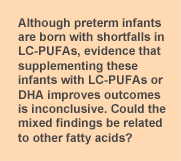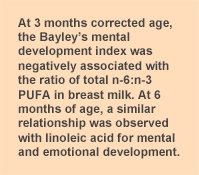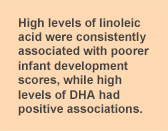
Preterm infants, who have very little body fat, are especially dependent on postnatal feeding for their nutrition needs. Because the transfer of LC-PUFAs from the placenta, which is most rapid in the third trimester, has been interrupted, these infants must obtain their LC-PUFAs from breast milk or preterm infant formula. There is some evidence that LC-PUFA supplementation of preterm infants improves neurodevelopmental outcomes, but several
recent reviews report inconsistent evidence of benefit from studies that vary in dose, timing and methods of testing. Nevertheless,
accretion of DHA in brain depends on dietary supply. The association between prenatal LC-PUFA status and neurodevelopmental outcomes depends in part on the age at which the outcomes are measured. As discussed by
Hadders-Algra, outcomes before the age of 4 months are related to the exposure to both DHA and ARA, while those measured after this critical time are dependent mainly on DHA concentrations. Other factors, such as maternal prepregnancy nutritional status and diet during pregnancy, may also contribute to the outcomes. Typical maternal diets in many Western countries are very
low in LC-PUFAs, especially EPA and DHA, and are high in n-6 PUFAs, particularly linoleic acid. This dietary pattern affects breast milk fatty acid composition. High n-6 PUFAs and Mead acid, a marker of essential fatty acid deficiency, have been associated with
poorer early developmental outcomes in preterm infants. These same authors also
reported that early developmental status in preterm infants was associated with later developmental outcomes. The present study investigated whether the developmental outcomes in preterm infants at 3 months of age and later developmental evaluations were associated with early breast milk LC-PUFA concentrations or the infants’ plasma phospholipids at 44 weeks gestational age. Fifty-one preterm infants with median gestational age of 34 weeks (interquartile range, 32 to 35 weeks) participated in the study. Two mothers were unable to breastfeed and their infants received human milk from a milk bank. Seven mothers stopped breastfeeding before 44 weeks’ gestational age. The median length of exclusive breastfeeding was 3 months.

Early development was evaluated at age 3 months using
quality of general movements, a neuromotor assessment appropriate for ages 2 to 4 months post-term with high predictive value for developmental disorders. Later development, except for the 3-month evaluation, was assessed using the Bayley’s Scales of Infant Development-II at 3, 6, 10 and 18 months corrected age. Breast milk fatty acids were measured in a pooled sample collected over 24 hours one week after delivery. Infant fatty acids were measured in plasma phospholipids from 45 infants taken at 44 weeks’ gestational age (1 month corrected age). Essential fatty acid deficiency (EFAD) was calculated as the ratio of Mead acid (20:3n-9) to ARA, sometimes called the
Holman Index. At 3 months corrected age, the quality of the infants’ general movements was negatively associated with the EFAD index of breast milk sampled at one week postnatal. The Bayley’s scores for mental and motor indexes were also inversely associated with the concentration of linoleic acid and the ratio of total n-6:n-3 PUFAs in breast milk, suggesting an adverse effect of high concentrations of linoleic acid on early development in preterm infants. At 6 months corrected age, the Bayley’s mental development index and emotional scores were negatively associated with linoleic acid concentrations in breast milk, but the emotional and orientation scores and motor index were positively associated with the infants’ phospholipid concentrations of DHA and ARA. Negative associations between the ratio of breast milk linoleic acid:alpha-linolenic acid and the mental development index and orientation score persisted until 10 months corrected age. In contrast, positive associations were observed for the infants’ phospholipid DHA concentration and mental, motor, orientation and emotional measures. By 18 months of age, only infant phospholipid DHA concentration was associated with the mental development index, while the ratio of ARA:DHA was negatively associated with motor and orientation evaluations. Adjustment of these relationships with confounding variables revealed a strong, positive influence of maternal education at all ages, but the pattern of negative associations with high breast milk linoleic acid content persisted. In the first 3 months of development, adjusted associations with breast milk fatty acids were significant only for n-6:n-3 PUFAs and the mental development index. At 6 months of age, breast milk linoleic acid was negatively associated with mental and emotional development and by 10 months only the linoleic:alpha-linolenic acid ratio was significantly inversely associated with orientation assessment.

The adjusted analysis also showed that the infants’ phospholipid ARA:DHA ratio was consistently inversely associated with mental and motor development scores at 10 and 18 months of age and with orientation at 18 months. The combined effects of PUFAs, LCPUFAs and confounders explained up to 38% of the variability in the development scores. The consistent relationships between the fatty acids in early breast milk or infant phospholipids with several aspects of infant development from 3 to 18 months of corrected age underline the importance of the fatty acid composition of breast milk and, by implication, maternal fatty acid availability in late pregnancy for preterm infants. High levels of linoleic acid were consistently associated with poorer infant development assessments, while high levels of DHA had positive associations. Interestingly, breast milk fatty acid concentrations for DHA and ARA were higher than the
worldwide averages for these LC-PUFAs. This observation might suggest that the negative effects of high linoleic levels in breast milk were not overcome by the amount of DHA available. Others have reported associations between mildly abnormal quality of general movements in 3-month-old term infants with
low arachidonic acid and
high Mead acid in umbilical arteries and infant erythrocytes, respectively. Mead acid is usually observed only in essential fatty acid deficiency. In
one report, eye and hand coordination was negatively associated with cord blood ARA in children at 2.5 years of age. There are several other reports of
adverse associations between Mead acid and various measures of neurodevelopment and learning. High levels

of
linoleic acid were consistently associated with poorer infant development scores, while high levels of DHA had positive associations. Although fatty acid ratios may obscure changes in the components of the ratio, high levels of linoleic acid were more consistently linked to negative developmental outcomes and DHA to positive outcomes through 6 months of age. Thereafter, higher ARA:DHA ratios were negatively associated with several developmental outcomes, suggesting an imbalance between these fatty acids with potentially suboptimal consequences for infant development. Correlations do not demonstrate causal links, but in this study they were suggestive of PUFA imbalances in the infants’ phospholipid fatty acids and the breast milk of women consuming typical Swedish diets apparently adequate in n-3 LC-PUFAs and high in linoleic acid. Sabel KG, Strandvik B, Petzold M, Lundqvist-Persson C. Motor, mental and behavioral developments in infancy are associated with fatty acid pattern in breast milk and plasma of premature infants.
Prostaglandins Leukot Essent Fatty Acids 2012;86:183-188. [
PubMed]
 Preterm infants, who have very little body fat, are especially dependent on postnatal feeding for their nutrition needs. Because the transfer of LC-PUFAs from the placenta, which is most rapid in the third trimester, has been interrupted, these infants must obtain their LC-PUFAs from breast milk or preterm infant formula. There is some evidence that LC-PUFA supplementation of preterm infants improves neurodevelopmental outcomes, but several recent reviews report inconsistent evidence of benefit from studies that vary in dose, timing and methods of testing. Nevertheless, accretion of DHA in brain depends on dietary supply. The association between prenatal LC-PUFA status and neurodevelopmental outcomes depends in part on the age at which the outcomes are measured. As discussed by Hadders-Algra, outcomes before the age of 4 months are related to the exposure to both DHA and ARA, while those measured after this critical time are dependent mainly on DHA concentrations. Other factors, such as maternal prepregnancy nutritional status and diet during pregnancy, may also contribute to the outcomes. Typical maternal diets in many Western countries are very low in LC-PUFAs, especially EPA and DHA, and are high in n-6 PUFAs, particularly linoleic acid. This dietary pattern affects breast milk fatty acid composition. High n-6 PUFAs and Mead acid, a marker of essential fatty acid deficiency, have been associated with poorer early developmental outcomes in preterm infants. These same authors also reported that early developmental status in preterm infants was associated with later developmental outcomes. The present study investigated whether the developmental outcomes in preterm infants at 3 months of age and later developmental evaluations were associated with early breast milk LC-PUFA concentrations or the infants’ plasma phospholipids at 44 weeks gestational age. Fifty-one preterm infants with median gestational age of 34 weeks (interquartile range, 32 to 35 weeks) participated in the study. Two mothers were unable to breastfeed and their infants received human milk from a milk bank. Seven mothers stopped breastfeeding before 44 weeks’ gestational age. The median length of exclusive breastfeeding was 3 months.
Preterm infants, who have very little body fat, are especially dependent on postnatal feeding for their nutrition needs. Because the transfer of LC-PUFAs from the placenta, which is most rapid in the third trimester, has been interrupted, these infants must obtain their LC-PUFAs from breast milk or preterm infant formula. There is some evidence that LC-PUFA supplementation of preterm infants improves neurodevelopmental outcomes, but several recent reviews report inconsistent evidence of benefit from studies that vary in dose, timing and methods of testing. Nevertheless, accretion of DHA in brain depends on dietary supply. The association between prenatal LC-PUFA status and neurodevelopmental outcomes depends in part on the age at which the outcomes are measured. As discussed by Hadders-Algra, outcomes before the age of 4 months are related to the exposure to both DHA and ARA, while those measured after this critical time are dependent mainly on DHA concentrations. Other factors, such as maternal prepregnancy nutritional status and diet during pregnancy, may also contribute to the outcomes. Typical maternal diets in many Western countries are very low in LC-PUFAs, especially EPA and DHA, and are high in n-6 PUFAs, particularly linoleic acid. This dietary pattern affects breast milk fatty acid composition. High n-6 PUFAs and Mead acid, a marker of essential fatty acid deficiency, have been associated with poorer early developmental outcomes in preterm infants. These same authors also reported that early developmental status in preterm infants was associated with later developmental outcomes. The present study investigated whether the developmental outcomes in preterm infants at 3 months of age and later developmental evaluations were associated with early breast milk LC-PUFA concentrations or the infants’ plasma phospholipids at 44 weeks gestational age. Fifty-one preterm infants with median gestational age of 34 weeks (interquartile range, 32 to 35 weeks) participated in the study. Two mothers were unable to breastfeed and their infants received human milk from a milk bank. Seven mothers stopped breastfeeding before 44 weeks’ gestational age. The median length of exclusive breastfeeding was 3 months.  Early development was evaluated at age 3 months using quality of general movements, a neuromotor assessment appropriate for ages 2 to 4 months post-term with high predictive value for developmental disorders. Later development, except for the 3-month evaluation, was assessed using the Bayley’s Scales of Infant Development-II at 3, 6, 10 and 18 months corrected age. Breast milk fatty acids were measured in a pooled sample collected over 24 hours one week after delivery. Infant fatty acids were measured in plasma phospholipids from 45 infants taken at 44 weeks’ gestational age (1 month corrected age). Essential fatty acid deficiency (EFAD) was calculated as the ratio of Mead acid (20:3n-9) to ARA, sometimes called the Holman Index. At 3 months corrected age, the quality of the infants’ general movements was negatively associated with the EFAD index of breast milk sampled at one week postnatal. The Bayley’s scores for mental and motor indexes were also inversely associated with the concentration of linoleic acid and the ratio of total n-6:n-3 PUFAs in breast milk, suggesting an adverse effect of high concentrations of linoleic acid on early development in preterm infants. At 6 months corrected age, the Bayley’s mental development index and emotional scores were negatively associated with linoleic acid concentrations in breast milk, but the emotional and orientation scores and motor index were positively associated with the infants’ phospholipid concentrations of DHA and ARA. Negative associations between the ratio of breast milk linoleic acid:alpha-linolenic acid and the mental development index and orientation score persisted until 10 months corrected age. In contrast, positive associations were observed for the infants’ phospholipid DHA concentration and mental, motor, orientation and emotional measures. By 18 months of age, only infant phospholipid DHA concentration was associated with the mental development index, while the ratio of ARA:DHA was negatively associated with motor and orientation evaluations. Adjustment of these relationships with confounding variables revealed a strong, positive influence of maternal education at all ages, but the pattern of negative associations with high breast milk linoleic acid content persisted. In the first 3 months of development, adjusted associations with breast milk fatty acids were significant only for n-6:n-3 PUFAs and the mental development index. At 6 months of age, breast milk linoleic acid was negatively associated with mental and emotional development and by 10 months only the linoleic:alpha-linolenic acid ratio was significantly inversely associated with orientation assessment.
Early development was evaluated at age 3 months using quality of general movements, a neuromotor assessment appropriate for ages 2 to 4 months post-term with high predictive value for developmental disorders. Later development, except for the 3-month evaluation, was assessed using the Bayley’s Scales of Infant Development-II at 3, 6, 10 and 18 months corrected age. Breast milk fatty acids were measured in a pooled sample collected over 24 hours one week after delivery. Infant fatty acids were measured in plasma phospholipids from 45 infants taken at 44 weeks’ gestational age (1 month corrected age). Essential fatty acid deficiency (EFAD) was calculated as the ratio of Mead acid (20:3n-9) to ARA, sometimes called the Holman Index. At 3 months corrected age, the quality of the infants’ general movements was negatively associated with the EFAD index of breast milk sampled at one week postnatal. The Bayley’s scores for mental and motor indexes were also inversely associated with the concentration of linoleic acid and the ratio of total n-6:n-3 PUFAs in breast milk, suggesting an adverse effect of high concentrations of linoleic acid on early development in preterm infants. At 6 months corrected age, the Bayley’s mental development index and emotional scores were negatively associated with linoleic acid concentrations in breast milk, but the emotional and orientation scores and motor index were positively associated with the infants’ phospholipid concentrations of DHA and ARA. Negative associations between the ratio of breast milk linoleic acid:alpha-linolenic acid and the mental development index and orientation score persisted until 10 months corrected age. In contrast, positive associations were observed for the infants’ phospholipid DHA concentration and mental, motor, orientation and emotional measures. By 18 months of age, only infant phospholipid DHA concentration was associated with the mental development index, while the ratio of ARA:DHA was negatively associated with motor and orientation evaluations. Adjustment of these relationships with confounding variables revealed a strong, positive influence of maternal education at all ages, but the pattern of negative associations with high breast milk linoleic acid content persisted. In the first 3 months of development, adjusted associations with breast milk fatty acids were significant only for n-6:n-3 PUFAs and the mental development index. At 6 months of age, breast milk linoleic acid was negatively associated with mental and emotional development and by 10 months only the linoleic:alpha-linolenic acid ratio was significantly inversely associated with orientation assessment.  The adjusted analysis also showed that the infants’ phospholipid ARA:DHA ratio was consistently inversely associated with mental and motor development scores at 10 and 18 months of age and with orientation at 18 months. The combined effects of PUFAs, LCPUFAs and confounders explained up to 38% of the variability in the development scores. The consistent relationships between the fatty acids in early breast milk or infant phospholipids with several aspects of infant development from 3 to 18 months of corrected age underline the importance of the fatty acid composition of breast milk and, by implication, maternal fatty acid availability in late pregnancy for preterm infants. High levels of linoleic acid were consistently associated with poorer infant development assessments, while high levels of DHA had positive associations. Interestingly, breast milk fatty acid concentrations for DHA and ARA were higher than the worldwide averages for these LC-PUFAs. This observation might suggest that the negative effects of high linoleic levels in breast milk were not overcome by the amount of DHA available. Others have reported associations between mildly abnormal quality of general movements in 3-month-old term infants with low arachidonic acid and high Mead acid in umbilical arteries and infant erythrocytes, respectively. Mead acid is usually observed only in essential fatty acid deficiency. In one report, eye and hand coordination was negatively associated with cord blood ARA in children at 2.5 years of age. There are several other reports of adverse associations between Mead acid and various measures of neurodevelopment and learning. High levels
The adjusted analysis also showed that the infants’ phospholipid ARA:DHA ratio was consistently inversely associated with mental and motor development scores at 10 and 18 months of age and with orientation at 18 months. The combined effects of PUFAs, LCPUFAs and confounders explained up to 38% of the variability in the development scores. The consistent relationships between the fatty acids in early breast milk or infant phospholipids with several aspects of infant development from 3 to 18 months of corrected age underline the importance of the fatty acid composition of breast milk and, by implication, maternal fatty acid availability in late pregnancy for preterm infants. High levels of linoleic acid were consistently associated with poorer infant development assessments, while high levels of DHA had positive associations. Interestingly, breast milk fatty acid concentrations for DHA and ARA were higher than the worldwide averages for these LC-PUFAs. This observation might suggest that the negative effects of high linoleic levels in breast milk were not overcome by the amount of DHA available. Others have reported associations between mildly abnormal quality of general movements in 3-month-old term infants with low arachidonic acid and high Mead acid in umbilical arteries and infant erythrocytes, respectively. Mead acid is usually observed only in essential fatty acid deficiency. In one report, eye and hand coordination was negatively associated with cord blood ARA in children at 2.5 years of age. There are several other reports of adverse associations between Mead acid and various measures of neurodevelopment and learning. High levels  of linoleic acid were consistently associated with poorer infant development scores, while high levels of DHA had positive associations. Although fatty acid ratios may obscure changes in the components of the ratio, high levels of linoleic acid were more consistently linked to negative developmental outcomes and DHA to positive outcomes through 6 months of age. Thereafter, higher ARA:DHA ratios were negatively associated with several developmental outcomes, suggesting an imbalance between these fatty acids with potentially suboptimal consequences for infant development. Correlations do not demonstrate causal links, but in this study they were suggestive of PUFA imbalances in the infants’ phospholipid fatty acids and the breast milk of women consuming typical Swedish diets apparently adequate in n-3 LC-PUFAs and high in linoleic acid. Sabel KG, Strandvik B, Petzold M, Lundqvist-Persson C. Motor, mental and behavioral developments in infancy are associated with fatty acid pattern in breast milk and plasma of premature infants. Prostaglandins Leukot Essent Fatty Acids 2012;86:183-188. [PubMed]
of linoleic acid were consistently associated with poorer infant development scores, while high levels of DHA had positive associations. Although fatty acid ratios may obscure changes in the components of the ratio, high levels of linoleic acid were more consistently linked to negative developmental outcomes and DHA to positive outcomes through 6 months of age. Thereafter, higher ARA:DHA ratios were negatively associated with several developmental outcomes, suggesting an imbalance between these fatty acids with potentially suboptimal consequences for infant development. Correlations do not demonstrate causal links, but in this study they were suggestive of PUFA imbalances in the infants’ phospholipid fatty acids and the breast milk of women consuming typical Swedish diets apparently adequate in n-3 LC-PUFAs and high in linoleic acid. Sabel KG, Strandvik B, Petzold M, Lundqvist-Persson C. Motor, mental and behavioral developments in infancy are associated with fatty acid pattern in breast milk and plasma of premature infants. Prostaglandins Leukot Essent Fatty Acids 2012;86:183-188. [PubMed]

